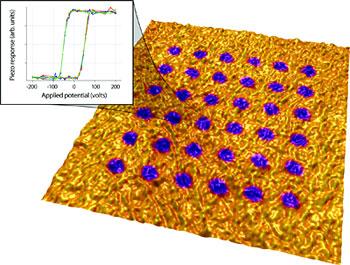
Piezo Force Microscopy Module
Oxford Instruments Asylum ResearchRequest Info
For Nanoscale Electromechanical Measurements
In the last decade, piezoresponse force microscopy (PFM) has emerged as the preeminent tool for nanoscale imaging, spectroscopy, and manipulation of ferroelectric materials. In response to the growing applications for electromechanical imaging and spectroscopy, Asylum Research said it has developed the new Piezo Force Module, which enables very high sensitivity, high bias, and crosstalk-free measurements of piezoelectrics, ferroelectrics, multiferroics, and biological systems. It is exclusively available for the company's MFP-3D atomic force microscope (AFM).
"Electromechanics and PFM is a growing area of research with studies ranging from data storage devices to MEMS (microelectromechanical systems) to electromotor proteins and electrophysiology. Our Piezo Force Module uses a special high voltage accessory and advanced imaging modes to measure piezoresponse, even for the weakest piezoelectric materials," said Roger Proksch, PhD, president and cofounder of Asylum Research. "We are extremely excited about the potential for advanced measurements in many different disciplines."

Rendered topography of a LiNbO3 sample with the PFM signal painted on top. The image was taken after switching spectroscopy mapping; inset shows the hysteresis loops measured at an individual point, 4-µm scan.
The Piezo Force Module is an MFP-3D accessory that enables high-voltage PFM measurements and advanced imaging modes for characterizing the sample material. With the module, a bias is applied to the AFM tip using proprietary electronics, a high-voltage cantilever, and sample holder. The vertical and lateral response amplitude measures the local electromechanical activity of the surface, and the phase of the response yields information on the polarization direction. High probing voltages, up to +220 V, can characterize even very weak piezo materials.
According to the company, exclusive patent-pending imaging modes and dual frequency resonance tracking and band excitation effectively use resonance enhancement in PFM and provide new information on local response and energy dissipation which cannot be obtained by standard AFM scanning modes. These techniques allow independent measurement of amplitude, resonant frequency, and Q-factor of the cantilever and overcome limitations of traditional sinusoidal cantilever excitation. The large frequency range (1 kHz-2 MHz) of MFP-3D allows imaging both at the static condition, and effective use of several cantilever resonances and use of the inertial stiffening of the cantilever.
Polarization dynamics can also be studied with the built-in spectroscopy modes that include single-point hysteresis loop measurements and switching spectroscopy mapping. These modes provide local measure of such parameters as coercive and nucleation biases, imprint, remanent response, and work of switching (area within the hysteresis loop), for correlation with local microstructure. Combined with the high-voltage module, these allow local polarization switching to be probed even in high-coercivity materials such as electro-optical single crystals.
Asylum Research is collaborating with Oak Ridge National Laboratory to conduct research on PFM at the Materials Science and Technology Div. and Center for Nanophase Materials Sciences. Many of their latest results were presented this week at the Materials Research Society's Fall 2007 Meeting in Boston; the Piezo Force Module was also introduced at the meeting.
"The recent work that we have done in collaboration with Asylum is already producing ground-breaking results," said Sergei V. Kalinin, PhD, staff scientist at ORNL. "The plethora of new and exciting electromechanical phenomena emerging on the nanoscale -- from electric field-induced phase transitions in ferroelectrics to electronic flexoelectricity and molecular electromotors -- has been belied by the lack of capability to study them quantitatively and reproducibly. PFM is the technique that enables these studies. Eventually, the development of nanotechnology will require the capability not only to 'think,' but to 'act' on the nanoscale. PFM will pave the way for the understanding of electromechanical coupling mechanisms on the nanometer scale and development of the molecular electromechanical systems."
For more information, visit: www.asylumresearch.com; e-mail: [email protected]Asylum Research Corp.
6310 Hollister Ave.
Santa Barbara, CA 93117
Phone: (805) 696-6466
Fax: (805) 696-6444
http://AFM.oxinst.com
/Buyers_Guide/Oxford_Instruments_Asylum_Research/c1206
Published: November 2007
REQUEST INFO ABOUT THIS PRODUCT
* First Name:
* Last Name:
* Email Address:
* Company:
* Country:
Message:
When you click "Send Request", we will record and send your personal contact information to Oxford Instruments Asylum Research by email so they may respond directly. You also agree that Photonics Media may contact you with information related to this inquiry, and that you have read and accept our
Privacy Policy and
Terms and Conditions of Use.
Register or login to auto-populate this form:
Login
Register
* Required